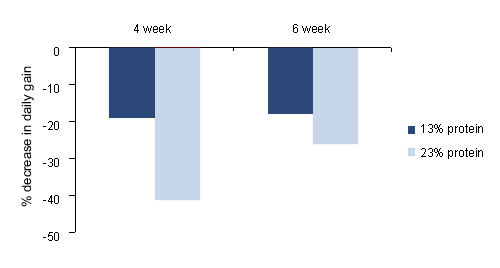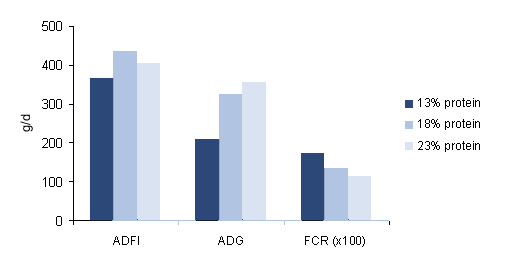Introduction
High protein starter diets have long been used, especially for early weaned pigs, as they are thought to help smooth the transition from milk to solid feed. However, high protein diets may encourage the proliferation of pathogenic bacteria in the gastrointestinal tract (Prohászka and Baron, 1980). The elimination of in feed anti-microbial growth promoters within the EU, due partly to concerns over increased antibiotic resistance to bacterial infections in humans, coupled with high protein starter diets may therefore increase the incidence of post weaning diarrhoea leading to poor performance or increased use of medicinal feed additives. Manipulating dietary protein supply by reducing protein content and/or increasing protein digestibility to reduce the amount of substrate for bacterial proliferation may be an effective means of maintaining piglet health in antibiotic free diets. These two options are discussed below.
Decreasing dietary protein content
Numerous studies have looked at the possibilities of limiting post-weaning diarrhoea by reducing the levels of protein in starter pig diets and thereby limiting the availability of non-digested protein to potential enteric pathogens. Wellock et al. (2006; 2008a,b) showed that reducing the level of dietary protein from 23 to 13% led to firmer faeces that contained fewer pathogenic bacteria and improved gut health with a higher ratio of good to bad bacteria leading to a decreased risk of post-weaning diarrhoea. This was especially true for piglets exposed to an experimental infection of enterotoxigenic Escherichia coli, the pathogens chiefly associated with post-weaning diarrhoea, and for those weaned at 4 rather than 6 weeks of age.

In these experiments amino acid content was maintained as a proportion of total protein with lysine accounting for 7% of total protein. Decreasing dietary protein to 13% had a large detrimental effect on growth, but this was not the case for piglets offered a diet containing 18% protein where pig performance in the immediate post-weaning period was similar to those fed 23% protein.

To minimise the detrimental effect on performance of lowering dietary protein level, whilst maintaining the beneficial effects to enteric health, Nyachoti et al. (2006) supplemented the low protein diets (210, 190 or 170 g CP/kg) with crystalline amino acids to achieve equal standardized ileal digestible contents of lysine, methionine plus cysteine, threonine and tryptophan in all diets. However a decrease in performance was also reported once dietary protein fell to 190 g CP/kg or below. Although the supplementation of amino acids is becoming increasingly common in commercial practice, it is more difficult to apply in starter diets without creating a potentially serious deficiency of non-essential amino acids. This is especially true in the EU where only 4 synthetic amino acids are currently available for use with synthetic valine and isoleucine not yet available. Thus it appears that whilst a moderate reduction (approx 2-3%) in dietary protein is quite feasible with little impact on performance, reducing protein beyond 4% while maintaining essential amino acid balance becomes increasingly difficult and is expected to reduce performance.
Improving protein quality
The use of more digestible protein sources in starter diets, e.g. by using animal protein sources in preference to plant protein sources, have been shown to improve gut health and result in improved growth performance. For example, the experiment of Wellock et al. (2006) demonstrated that pigs offered diets based on dried skimmed milk powder consumed more feed, had greater rates of gain and improved feed conversion ratio than those offered soya based diets. Although all pigs remained clinically healthy the results also indicated that the risk of post weaning diarrhoea was higher for pigs fed the soya based diet due to an increased fluidity of faeces and a reduction in gut health as indicated by a decrease in the lactobacilli to coliform ratio and increase in gastrointestinal pH. This improved post-weaning growth rate may reduce time taken to reach slaughter (Tokach et al., 1998; Lawlor et al., 2003). While the above concentrates on the protein quality as determined by the digestibility of protein sources, it must be noted that some protein sources, such as milk powder, may also supply other proteins that have a secondary role not related to the supply of nutrients, such as immunoglobulins and growth factors, which may be equally important in piglet nutrition. For example, Miller and Toplis (2000) reported that offering an additional 60 g/d whey protein concentrate, which typically contains Ig levels of 4% protein, for 4 days post weaning increased piglet weight by 0.5 kg (12.7 versus 12.2 kg) at 20 days post-weaning with.
Conclusion
In order to apply the most suitable feeding regime to newly weaned pigs it is important to balance the trade off between the detrimental effect on performance of feeding levels of protein that are too low to allow maximal growth and those which increase the risk of post weaning diarrhoea. This will very much depend upon the management system and the conditions in which the pigs are kept, and will be particularly important in earlier weaned pigs and in environments where antimicrobial growth promoters are no longer permitted. Including highly digestible protein sources in starter diets is one way in which performance may be maintained whilst maintaining health.




